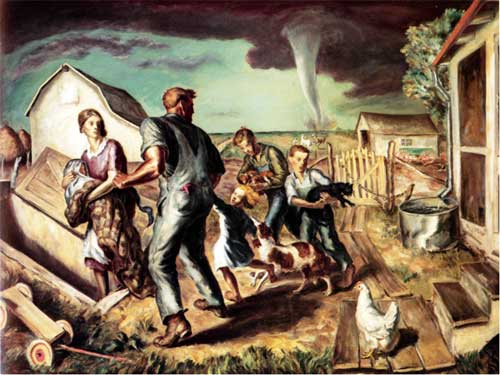 The tornadoes ripped through the heart of the Bible belt, so you knew what was coming in the mainstream coverage -- Godtalk. There simply isn't a way for reporters, even elite reporters, to talk to ordinary Americans under tragic circumstances without eternal issues coming up.
You could see a hint of that in the headline that topped the A1 story, with lead color art, at the New York Times. It proclaimed, with just a touch of omnipotence: "Tornado Swarm Deals Death, but Also Miracles."
The tornadoes ripped through the heart of the Bible belt, so you knew what was coming in the mainstream coverage -- Godtalk. There simply isn't a way for reporters, even elite reporters, to talk to ordinary Americans under tragic circumstances without eternal issues coming up.
You could see a hint of that in the headline that topped the A1 story, with lead color art, at the New York Times. It proclaimed, with just a touch of omnipotence: "Tornado Swarm Deals Death, but Also Miracles."
The miracles were, of course, performed by the tornadoes themselves.
However, I must admit that the story captures some classic examples of the tragic, bizarre and touching events that take place inside the zones shaped by the physics of tornadoes (it helps to know that I grew up in the tornado alley near the Red River in North Texas). Here's a sample of material from the top of this very well-written report:
There was Glen White, 24, who found the strength to push up a wall that had fallen on five residents of a group home. There was the married couple who were thrown into their backyard as the storm exploded their home. They landed close enough, battered and bruised, to hold hands. And there was Molly, a graying donkey who for years has starred in the town Christmas pageant. People say they saw her lifted into the funnel cloud when the storm hit Saturday night. They thought she was a goner. ...
Yes, 11 people died in those dark and deafening 10 minutes. Dozens were hurt and homes were destroyed.
As people picked through the mess and showed up with water and fried chicken at temporary shelters Monday, everyone seemed to mix their grief and shock with a sense of marvel that a mile-wide tornado that blew through this land of peanut fields and chicken houses with 165-mile-an-hour winds didn’t do worse.
There's much more where that came from. However, as I read through the story I kept waiting for the other shoe to drop. I mean, I've been visiting rural North Carolina for decades and spent six years just on the other side of the mountains from Asheville. You can't go a mile in that corner of the world (OK, maybe five miles) without hitting a Baptist or Methodist church. I know how these folks talk.
So, I wondered, where was God in all of this?
Sure enough, God made the cut in this story -- but barely. This is how the piece ends.
There will be cleaning up to do and funerals to plan. People will wait to see if insurance will help them rebuild. They will count their blessings as they mourn their losses, and talk of God’s plan and God’s work. And they will cheer the resilience of the town’s most famous donkey.
“Molly’s going to make it to one more Christmas play,” said Tiffany Everett, 44, who had driven to the destroyed group home to lend a hand.
So the faith-friendly voices were there, their quotes just weren't good enough to make it into print.
All this reminds me of that encounter I had long ago with the late Peter Jennings of ABC News. I have quoted this here before at GetReligion, but it precisely describes what I think is going on in this Times report.
Jennings and I were discussing this question: Why do so many mainstream reporters have trouble handling religion news? What is the heart of this problem?
Anyone who has watched television, said Jennings, has seen camera crews descend after disasters. Inevitably, a reporter confronts a survivor and asks: “How did you get through this terrible experience?” As often as not, a survivor replies: “I don’t know. I just prayed. Without God’s help, I don’t think I could have made it.”
What follows, explained Jennings, is an awkward silence. “Then reporters ask another question that, even if they don’t come right out and say it, goes something like this: ‘Now that’s very nice. But what REALLY got you through this?’ “
For most viewers, he said, that tense pause symbolizes the gap between journalists and, statistically speaking, most Americans. This is not a gap that is in the interest of journalists who worry -- with good cause -- about the future of the news.
What he said.
